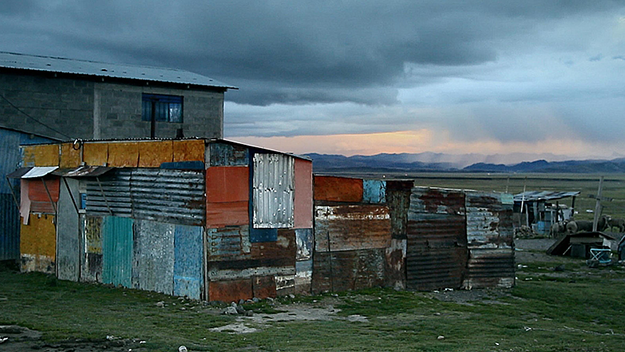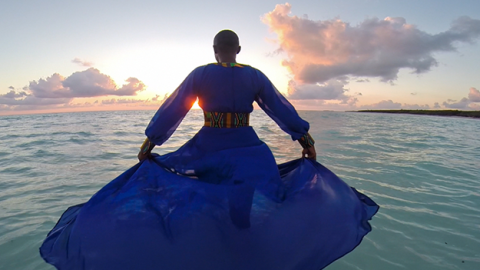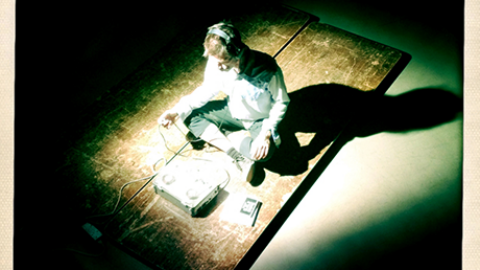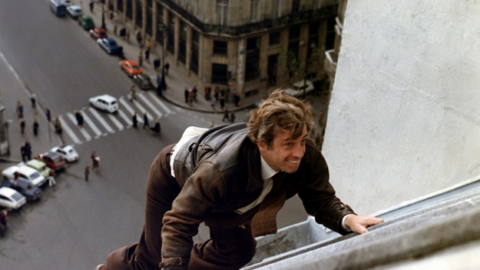Festivals: Oberhausen

HDHB
The somewhat contentious topic of curation was at the forefront of the 62nd edition of the Oberhausen Short Film Festival. At one of the Podium sessions, art historian Hans Ulrich Gumbrecht gruffly declared that he found the practice “annoying” for taking attention away from artworks themselves. The culprit, for him, was “discursivity,” the tendency to let interpretation get in the way of the artwork, and a condition no doubt aggravated by the other panelists’ attempts to defend the practice. Gumbrecht’s excoriations notwithstanding—don’t we all find curating annoying?—the debate was perhaps misguided. When asked by an audience member about the differences between curating, which has a stronger art world connotation, and programming, which has been more traditionally used in film contexts such as this, the panelists faltered, and the discussion continued instead among the many programmers seated in the room.
While the issues of curation raised by the panel—the professionalization of the practice, the market valuation of contemporary art, the rise of the celebrity curator, and a culturally generalized notion of curation in everything from clothing to yogurt flavors—were worthy of consideration, the panelists’ inability to account for programming was telling, especially at a festival like Oberhausen, which is entirely composed of short films, including a sizable number of experimental films, documentaries, and, increasingly, videos made for a gallery context. Oberhausen is unusual for the extent of its overlap across the art and film worlds. While other film festivals might make overtures toward inclusion, highlighting work by artists in their programming or mounting installations in adjacent exhibition spaces, they rarely question the primacy of cinema as a form and institution. Oberhausen, meanwhile, has put forth the serious consideration that short film today cannot be considered apart from the exhibition and funding structures of the art world. While the Podium session on curation shows how distant these two domains remain to each other (though I am inclined to think the art world is especially guilty in ignoring most of what happens in experimental film), the festival as a whole deserves credit for inviting numerous programmers and curators, hosting its series of Podium discussions, mounting installations and screenings for two featured moving image artists, and, new this year, running a Positions program featuring talks by gallerists, curators, and other art world professionals working with moving image media. Though it might be tempting to grumble with Gumbrecht about discursivity, making these conversations explicit had the larger benefit of offering an opportunity for a festival programmer here or a museum curator there to consider their own practices within a larger context.
The festival slate also encouraged this reflection. In addition to its international competition and various regional programs, numerous distributors were also on hand to present highlights from their collections. This not only provided a view of the character of each distributor, but more practically introduced distributors to programmers, many of whom I saw scribbling notes in the audience. So far as I’m aware, Oberhausen is the only festival to feature distributor screenings; in this way it’s something of a meta-festival, geared largely for programmers seeking out work to show in their own festivals. Perhaps because of this, these screenings were especially strong, and several films stood out for their takes on contemporary life. Not coincidentally, these tended toward documentary, which, for many years now, has been the area where experimental and artist films have been most dynamically explored. In Ayman Nahle’s Now: End of Season (15), presented by the Berlin-based Arsenal, a sense of dread looms over shots of suitcases idling in a public square in Turkey. The camera passes over the luggage from a faraway position: do they belong to Syrian refugees? Are any of them carrying bombs? Whether these images indicate a disaster to come, or one that has already happened, is made ambiguous by the archival recording of a phone call being set up by the handlers for Presidents Hafiz al-Assad and Ronald Reagan. As they work to get the two world leaders on the line—Reagan is out riding horses, and Assad, we can only assume, is growing more frustrated by the minute—the feeling of anticipation grows, apparently sealing an irreversible historical fate.
Electronic Arts Intermix, from New York, included in their program What Portland Thinks About Technology at 3:00AM (14), by Andrew Lampert, a mini-road trip along a 140-block stretch of Portland. Lampert and his companion stop to interview people they meet on the street, which, in this early morning hour, results in responses as incoherent as you might expect. When asked about an older form of technology he wishes he’d experienced, one man responds with “the coal age,” while another proclaims that the greatest benefit brought by technology is the ability to locate registered sex offenders in his neighborhood. These Portlanders’ understanding of technology is wildly distorted and frequently erroneous, but what Lampert captures is the way their fears and desires are deeply tied up in the digital infrastructures that surround them. Corin Sworn and Charlotte Prodger’s HDHB (11), screened by the U.K. distributor LUX, offered a more abstracted view of the same digital situation. The film begins with color field frames and gradually focuses into a shot of the sea. The voiceover, meanwhile, undermines what we see, wondering: how distinctive is this image, if there are so many other photographs that have been taken of the same body of water? As the film progresses into more recognizable imagery, namely downloaded rips of Hollywood movies, the voiceover continues to muddle the clarity of what we see, asking us to consider the past and future audiences—ourselves among them—implied but left unacknowledged by these images.
The Day Before the End
The festival’s centerpiece was the international competition, though this also tended to be the most uneven of its sections, with each screening a seemingly random mix of short fiction, animation, and experimental work. Fortunately, the awards went to deserving films, again in a documentary vein. The Grand Prize was awarded to Louise Carrin’s Venusia (15), a riveting portrait of two sex workers, one a madame and the other one of her more experienced employees, chatting in the break room. Though set in a brothel, their conversation, which unfolds over an unspecified period of time, deals far less with sex than the tedium of their work. Their concerns are exceedingly ordinary, though no less fascinating owing to the psychodynamics that unfold between a boss who wishes to both nurture and control her most trusted protégé. The second-largest prize went to Lav Diaz’s The Day Before the End (15), set amid an imminently apocalyptic rainstorm on a city street. The film, which at 16 minutes is very likely Diaz’s shortest, also condensed his tendency to mix jaw-dropping imagery with forced profundity, here the clumsy contrivance of having actors recite lines from Shakespeare plays, seemingly chosen at random. These scenes, though, were rescued by more atmospheric shots of the same individuals walking through alleyways or sitting in cafes, and by the film’s end, a brooding, otherworldly sequence of people wading through waist-high flood waters. Diaz’s visual lyricism was only topped by Rajee Samarasinghe’s If I Were Any Further Away I’d Be Closer to Home, a silent, black-and-white portrait of Sri Lankan noodle-maker and his family. Shot in HD scope with a vintage anamorphic projector lens mounted to the digital camera, the film is as attentive to the rolling, cutting, and drying batches of long noodles as it is to the shifting patterns of natural light in and around their small workroom, in which a small girl stares up at the swirling dust around her.
20 July 2015, by Deimantas Narkevičius, earned a special mention, and it offered one of the most surprising and effective uses of 3-D I’ve ever encountered. The film presents itself, at least initially, as the straightforward filming of the removal of Soviet-era statues flanking the ends of the Green Bridge in Vilnius. Increasingly, however, shots extend to include the cameraman sloppily clapping his hands together for synch. It is as if the camera’s attention has shifted away from its documentary interest to its own filming, drawn to the disaffected cameraman whose presence comically disturbs the frame. His clapping also interrupts the 3-D effect; while the massive, thick-limbed farmers and Red Army soldiers remain unmoving in the background, the sudden foreground appearance of the cameraman’s hands, or his scrunched-up face as he wipes the lens, a cigarette dangling from his lips, mars the coherence of the 3-D image. The use of 3-D becomes allegorical, a sign of present disturbances (which includes the act of filmmaking) throwing the certainty of the past into disarray. Another competition film, Pavel Medvedev’s Hubris (15), tapped into the monumentalization of a political figure, with Vladimir Putin its subject. The film cleverly emphasizes the pomp and hushed excitement as he (then chairman of the party) and Prime Minister Dmitry Medvedev arrive at the 11th United Russia Party Congress in 2009. As Putin addresses his audience of party elites, Medvedev (the filmmaker) cuts to the reporters watching him in simulcast. Though the audience on the convention floor hangs on Putin’s every word—the spaces inside the auditorium are edited so that even the slightest cough elicits thunderous applause—those in the adjacent spaces register looks of boredom, their backs turned to the simulcasting monitors, and one woman wearily resting her head against the back of her chair. The formalities begin to appear as just that: forms and hollow gestures, as empty as the champagne glasses waiting to be filled at a lavish reception, or the joke one bureaucrat makes to another when he suggests, “Let’s pretend we are preoccupied.”
The festival’s strongest argument for curation, meanwhile, came from the Theme program, this year organized by Federico Windhausen around the notion of “el pueblo,” which can mean a location or a people. For the New Latin American Cinema of the ’60s and ’70s, the term acquired a political urgency, though as Windhausen noted in his introductions, this meaning had become fragmented and diffuse in contemporary regional filmmaking. In each of the eight screenings, this changing perspective was maintained by showing historical films among newer work in often unexpected and provocative combinations. Exemplary among these was the pairing of El palacio (13) by Nicolás Pereda with Fake Fruit Factory (86), by Chick Strand. The former, which the director described during the Q&A as a kind of utopia, imagines a space in which women of all ages teach each other the tasks of domestic labor, from turning on a washing machine to administering a sponge bath. The focus here is on gesture, and the slight variation that comes with repetition: sweeping, folding, tucking in the corners of a bed. The frame is almost always fixed and wide, calmly surveying the women as they work, and learn to work together, in a house that, for this film anyway, is set up for and only them. Pereda uses every corner of the frame, as in one shot where a few women clear and wash dishes at an outdoor sink. The orchestration of their tasks is mostly wordless, and we see, through an open window, a few others sitting at a kitchen table, while periodically the foreground is punctuated by the appearance of a white dog begging for scraps. The film’s relative lack of dialogue was all the more striking in comparison to the abundance of chatter in Fake Fruit Factory, another film about women at work, this time in a factory in Mexico. As the women mold and paint papier-mâché gourds and watermelon slices, they giggle and gossip about a coworker impregnated by their American boss. Strand watches them, and especially their hands, in extreme close-up as they dip fake cabbages into a glaze bath or hold a tortilla with a black rubber glove. The shakiness of the camera indicates how far she is standing back, and how deliberate was her choice in not showing more. Both films forego a medium view of the individual in favor of the group, either seen working together as in El palacio or evoked through small gestures like the passing of a plate in Fake Fruit Factory. This omission allows us to see these spaces of women’s work in ways not typically available, namely how the sharing of labor can amount to a supportive and even utopian sense of community.
Contornos
Over the course of the festival, the Theme developed in nuance and rich detail, rewarding sustained engagement, and in so doing, making the implicit case for a festival experience unfolding in time. There were numerous connections to be found across screenings, as in the largely vacant worksites of Jorge Scobell’s RH Reporte (14) and Ximena Garrido-Lecca’s Contornos (14). The former examines the spaces of a Korean-owned “global factory” in Mexico, a place where electrical parts are manufactured by a handful of workers clad in white jumpsuits. The clinical orderliness of the space, reminiscent of Lewis Baltz’s industrial photographs, is overlaid with a voiceover that describes the new protocols of this factory in which workers are required to submit biometric data to manage their productivity, their lives “reduced to one vital activity” inseparable from the machines they tend. The voice speaks in the past tense, as if this were a moment that had already occurred, its changes irreversible. Contornos, meanwhile, addresses several pasts at once, combining slow pans of a defunct Andean mine and the depressed town surrounding it with the voice of a guide explaining the geological history of the neighboring Huayllay Stone Forest. “If we could live 500 years,” he says, “we could notice how many rocks fall down.” Our perspective, the film implies, is too limited, and often we only notice the environmental effects of both natural and man-made forces long after they’ve taken shape. This idea is confirmed by the camera, which, over the course of the film, pulls back, revealing the jagged depth of the mine.
The Theme also packed a few surprises that even the filmmakers could not have anticipated. In the madcap, found footage sci-fi of Cocô Preto (03), a Super-8 performance by Marcos Bertoni, the demented song of an invading alien (who had come to earth for his professed love of Brazilian music) was not only translated but also sung by the interpreters at the screening. Never before, and never again, do I expect to be treated to the lilting refrain of “black poop” in a headset at an international film festival. Inasmuch as every screening is something of a live event, Cocô Preto was truly unforgettable, and it earned the translators their own, very deserved round of applause. Oberhausen concluded with a party, and thanks to the Theme filmmakers, this too took a spontaneous turn. When Cindy Keefer of the Center for Visual Music—she was at the festival to premiere rare film tests by Oskar Fischinger—heard that the Brazilian filmmakers had brought their own music, she walked up to the DJ and persuaded him to allow them to take over. Soon the beat quickened, the crowd swelled, and those who had resolved to turn in danced well into the next day.
Genevieve Yue is an assistant professor of Culture and Media at Eugene Lang College, The New School. Her essays and criticism have appeared in October, Grey Room, Reverse Shot, FILM COMMENT, and Film Quarterly.








